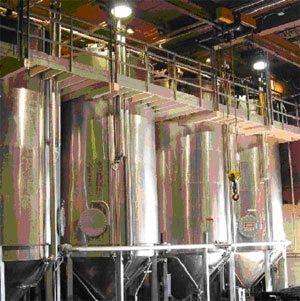
Home |
Client List |
Careers |
Contact Us |
Site Map |
| About Us | Machines | Plants & Projects | Services | Why Us? | News | More Links |
:: OUR PRODUCTS ::
Welcome to S.F. Engineering Works Greese Plants
 |
MANUFACTURING OF GREASE The manufacture of a grease involves dispersion of a thickener in the oil. The thickener or jelling agent in over 90% of greases is a metallic soap. The usual method by which a metallic soap thickener is formed can be described as follows:
This reaction is carried out by cooking the fatty material and alkali with normally some oil in order to get the soap well dispersed and also to make it softer and easier to stir. Such a procedure produces a wet soap partially dispersed in the mineral oil. It is then cut back with additional mineral oil to produce consistency desired in the finished grease. The soap oil mixture is a plastic mass with a tough fibrous structure. After the cut back operation. It is necessary to further process the grease by kettle milling or homogenization to modity its structure. The grease is then deaerated to remove entrained air and then filtered to remove any contaminants they may have been picked up during manufacture. |
|||||||||||||||||||||||||||||||
The manufacture of greases therefore involves the following steps, some of which may be accomplished simultaneously.
The operations are carried out in vessel known as grease kettle, which is equipped with some form of agitation and with heating facility. The agitation is usually of the double acting type that is it has a set of paddles rotating in one direction with a second set rotating in the opposite direction. The rate of cooling is very important in the development of the proper structure for many types of grease. Hence, close temperature control is required to manufacture a grease of desired properties. The structure of the grease can be modified by milling which can be carried out in the kettle itself during the cooling period or may be done outside the kettle. For out side milling, a high shear rate gear pump, homogenizer or colloid mill is normally used. Depending upon the types of grease, the total time required for manufacture of a grease batch in a kettle varies from 10 / 20 hours. GREASE CHARACTERISTIC TESTS
Performance tests
NLGI Grade Numbers
It will be observed that there is a difference of 30 units in each NLGI grade Numbers. And in between 2 grades there is a difference of 45 units. National lubricating grease institute – U.S.A. |
||||||||||||||||||||||||||||||||
 |
RAW MATERIAL The fatty material used to form grease making soaps are mainly of animal origin but also include vegetable and marine oils and fats. They can be used as the original glycerides or as the fatty acids split from the glycerides or fractions thereof recovered by filteration distillation or solvent crystallization. Hydrogentated oils are also used especially fish oils and castor oil, the latter being important as the source of 12- hydroxyl stearic acid. Most fats contain both saturated and unsaturated acids in the range C 12 to C 18 chain length, and in some cases (especially fish oil) to C 20 and C 22. The C 16 and C 18 acids preponderate. The type of material affects the melting point of the soap, and the degree of unsaturation may affect grease texture. Fatty Material
|
|||||||||||||||||||||||||||||||
Saponification value: Is an indication of average molecular weight and hence approximate composition (if no unsaponifiable matter is present) and is a measure of the amount of alkali needed to convert it to soap. Neutralisation Number: Measures the amount of the fatty acid present. Iodine Value: Indicates the extent of unsaturation. Too much unsaturation leads to poor oxidation stability, so high Iodine values (0ver 60-70), are avoided and values of 35 or less are preferred. Alkalies Calcium Hydroxide: is used in the form of hydrated lime, which should be finely ground to pass 200 mesh and with a low content of carbonate which does not saponify easily, limits of 95% Ca(OH)2 minimum and 2.0 % CaCo3 maximum have been recommended. Sodium Hydroxide: Usually supplied as solid or flake caustic soda but usually used in concentrated aqueous solution: should be at least 99% purity. Lithium Hydroxide is supplied as the crystalline monohydrate LioH, H2o with LiOH 55% minimum and Carbonate and other alkali metals less than 1.0% by wt. each. While most greases are made from soaps formed in situ, pre-formed or pre-made soaps supplied by chemical manufacturers are used to some extent.
Additivies Oxidation: Oxidation inhibitiors are widely used in greases in much the same way as in lubricating oils in order to improve the characteristics in particular respect e.g. to obtain longer storage and service life. Rust Inhibitors EP – Additives
Solid Additives (Fillers) Graphite. |
||||||||||||||||||||||||||||||||